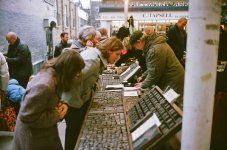takeda72
Established
Ok, I'll try to shed some light here.
Leica Glow, or traditionally what people call Leica Glow is some sort of light bleeding that occurs on highlight areas and bleed out : causing a glow.
Certain older lenses have this characteristics and some people like it a lot for black and white photography.
Found a photo on Flickr, from other photographer, which shows this perfectly :
http://www.flickr.com/photos/andretakeda/3335606778/
Note the woman's face, seems that the light "bleed" over the flace to the rest, causing what people usualyl call the "leica glow".
On color , usually gets to the form of glowing and chromatic aberrations but blurred, like this one :
http://www.flickr.com/photos/aryschien/2897810401/
( look at the ipod )
Lately, people just tend to use the expression Leica Glow to define some lens as in their ability to draw the picture, rendering an almost 3D effect to it or very well defined sharpness...
so take your pick, hope it helped
What a surprise to see my photo linked here... I was wondering why I had more than 100 views in this image today.
Actually I don't know what glow is. But when I saw this photo I said to myself: "maybe we have something here...".
Regards.
André





